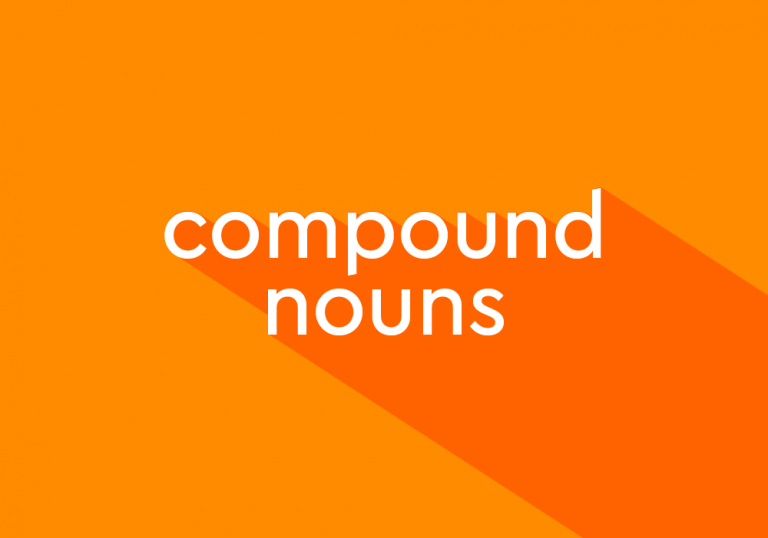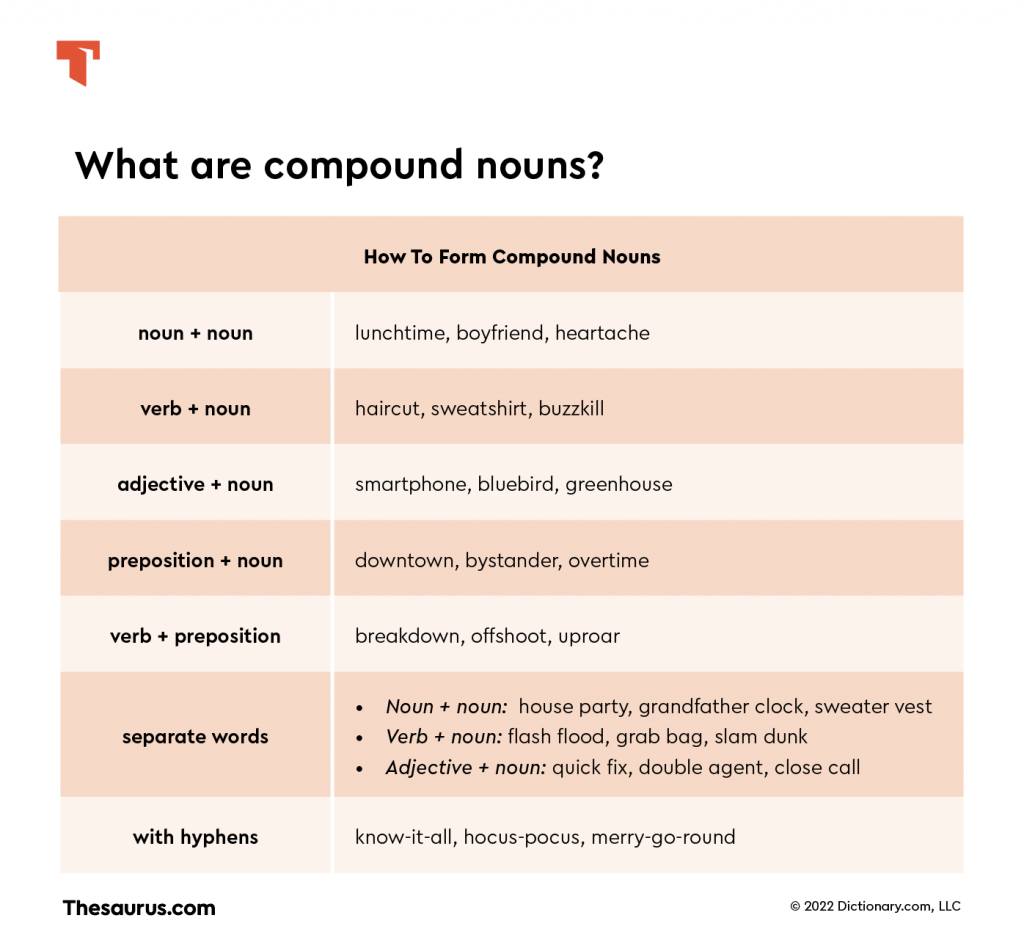What Are Compound Nouns And How Do You Use Them?

Last night, I took my roommate to a drive-in to see the latest blockbuster. It was a fun night, but it was also an example of an event that can be described with nouns. Not just any nouns, though. We use many different types of nouns to refer to people we love, places we take them, and things we enjoy together, but my story uses a couple examples of one particular type of noun: the compound noun.
What is a compound noun?
In grammar, a compound refers to a word that is made up of two or more existing parts or elements. Adjectives, verbs, prepositions, and nouns can all be described as compounds.
As compounds, they are made of two or more existing words combined into one, such as housetop (noun), many-sided (adjective), playact (verb), or upon (preposition).
A compound noun, in simplified terms, is a noun made up of two or more existing words. They are extremely common in English. The word snowstorm is an example of a simple type of compound noun formed from the words snow and storm. Compound nouns aren’t just formed from nouns but other types of words as well, such as verbs, adjectives, and prepositions. You can see this in words like runoff, takedown, and shortcake.
One main thing to keep in mind about compound nouns is that they have a meaning that is distinct from their component parts. For example, a blackboard is an object that a teacher writes on with chalk while a “black board” is any black piece of wood.
Compound noun examples
In English, there are three main ways that we form compound nouns. As is often the case in English, there is no single rule that states which of these methods is correct when it comes to forming specific compound nouns. You will either need to memorize compound nouns as you come across them or use our fantastic dictionary to see which form (or forms) should be used.
Compound nouns as a single word
This type of compound noun is formed by combining two words (from different parts of speech) together into a single word. Here are examples of compound nouns formed from pairs of different types of words:
- Noun + noun: lunchtime, boyfriend, milkman, firefighter, hatrack, heartache
- Verb + noun: jailbreak, haircut, runtime, turntable, sweatshirt, buzzkill
- Adjective + noun: smartphone, bluebird, redhead, greenhouse
- Preposition + noun: downtown, bystander, underworld, overtime
- Verb + preposition: breakdown, offshoot, downturn, input, uproar
Compound nouns as separate words
This type of compound noun is formed by using two separate words together that are acting together, grammatically, as a single unit. This type of compound noun is different from a noun phrase because one word isn’t acting as a modifier of another. You need to be careful with this type of compound noun as they may look identical to an instance of two separate words that aren’t being used as a compound noun. For example, the compound noun hot dog refers to a food while the separate words “hot dog” refers to a hairy animal that is very warm (and a good boy).
- Noun + noun: house party, grandfather clock, sweater vest, Christmas tree
- Verb + noun: flash flood, grab bag, jump cut, slam dunk, shock jock
- Adjective + noun: quick fix, easy money, slow burn, double agent, close call
Compound nouns with hyphens
This type of compound noun is often confused with the other two types. Using hyphens to form compound nouns is particularly common in newer or rarely used words. If a compound noun is formed from more than two words, it will almost always use hyphens.
- know-it-all, mother-in-law, show-off, court-martial, jack-in-the-box, jack-of-all-trades, Johnny-come-lately, city-state, hocus-pocus, merry-go-round
Plural forms of compound nouns
Until now, we have only looked at singular nouns. However, there are different rules about how to make compound nouns into plural nouns depending on which of the three types you are dealing with.
Plural of single-word compound nouns
Of the three, this type of compound noun is the most likely to follow the rules of plural nouns. You can take a look at our article on plural nouns if you need a refresher, but the usual method is to add -s or -es to the end of the compound noun. For example, chalkboard becomes chalkboards and eyelash becomes eyelashes.
Plural of multiple-word compound nouns
This type of compound noun gets more complicated. Sometimes, these words stick to the rules, and all you need to do is make the last word plural as in wedding planners or soft drinks. However, things can get more complicated. For example, the plural of attorney general is attorneys general. The reason is that the word attorney is acting as the main word and general is specifying what job the attorney has. In this case, it makes more sense to turn attorney into a plural when referring to more than one attorney general. Keep this in mind as we look at our last type of compound noun.
Plural of compound nouns with hyphens
Once again, things get complicated. Sometimes, hyphenated compound nouns follow the rules and get an -s or -es added onto the last word as in jack-in-the-boxes or fixer-uppers. Other times, though, hyphenated compound nouns don’t follow the pattern as in sisters-in-law or runners-up. As was the case in multiple-word compound nouns, these words turn the main word rather than the final word into a plural.
List of compound nouns
Let’s look at more examples of compound nouns. As you read each of these nouns, think about what words were used to form them and how the meanings of these nouns differ from the words used to make them.
- artwork, basketball, card shark, double dip, earmark, fast track, gold rush, half-and-half, icebreaker, junk mail, kangaroo court, ladybug, mother-of-pearl, night-light, odd-job, post office, queen bee, riverbank, small fry, think tank, upperclassmen, victory lap, whiz kid, yardstick, zookeeper
The difference between compound & collective nouns
Up until now, we have looked at many different examples of compound nouns. Compound nouns are formed by combining multiple words together to make a single noun. Another type of noun also brings several things together to form a single noun. A collective noun is a noun that collectively refers to multiple people or objects as a single entity. The words army, gang, pile, stack, group, and bunch are all examples of collective nouns. Unlike compound nouns, collective nouns don’t need to be formed from multiple words.
For the most part, both compound nouns and collective nouns follow the rules that all other nouns follow. Both can be singular nouns or plural nouns. Both can be concrete nouns or abstract nouns. Both can be possessive nouns.
Try another noun on for size, and see what you know about proper nouns.
Although rare, it is possible for a noun to be both a compound noun and a collective noun. For example, the word homeroom is a compound noun formed from the words home and room. At the same time, homeroom can be used as a collective noun to refer to a group of students.
Take a look at some example sentences. Read each sentence and see if you can understand what makes each given noun a compound noun, a collective noun, or both.
- I can’t handle the heartbreak of losing a pet.
- Our team won the championship.
- Two of my friends are members of the glee club.
- The goblin kingdom crumbled due to a civil war.
- The cruel billionaire looked down on the lower class.
Answer: 1. Compound 2. Collective 3. Both compound and collective noun 4. Compound 5. Both compound and collective noun
